- 3 Easy, Reliable, Productive Cut Flowers: Sunflowers, Zinnias & Rudbeckia
- 5 Factors That Determine Vase Life of Cut Flowers
- 2019 American Flowers Week: Combining the Art of Floral Design & Couture
- Celebrate the 7th American Flowers Week | Johnny's 2021 Botanical Couture
- Celebrating the 8th American Flowers Week | Johnny's 2022 Botanical Couture
- Collective Selling Models for Flower Farmers: Flower Hubs That Work
- 5 Cool Flowers to Plant Now | Lisa Mason Ziegler's Secrets for Growing Hardy, Cool-Season Annuals
- Cut-Flower Harvesting & Post-Harvest Care | Best Practices from Pros in the Slow Flower Community
- Cut-Flower Kit | Guide for Market Growers (PDF)
- Easy Cut-Flower Garden Map | For Growers New to Flowers (PDF)
- Easy Cut-Flower Garden Planner | For Growers New to Flowers (PDF)
- From Color to Climate: 5 Floricultural Trends Subtle & Seismic
- Flower Culture by Crop | Comparison Chart | Days to Germination, Weeks to Transplant, Days to Harvest (PDF)
- Flower Farmers' Favorite Fillers & Foliage | Recommendations from 3 Farmer-Florists
- Getting Started in Cut-Flowers | Top 15 Cuts
- Heat & Drought: How Flower Farmers Are Adapting to Changing & Challenging Climatic Conditions
- Introduction to Overwintering Flowers | Guide to Overwintering Flowers
- An Introduction to Producer Marketing Cooperatives | M Lund & Associates
- How Day Length Affects Cut-Flower Production
- Growing Flowers in Hoophouses & High Tunnels: Cool-Weather & Hot-Weather Options
- Growing Flower Seedlings for Profit
- Roadside Flower Stand Basics: Success Tips for On-Farm Retail
- Starting a U-Pick Flower Farm, From A-to-Z
- Year-Round Flower Production Strategy
- Overwinter Flower Trials | Multiyear Results for 30+ Crops | Johnny's Selected Seeds | XLSX
- Seeding Date Calculator | Johnny's Recommended Flowers for Overwintering | XLSX
- Just Add Flowers | An Introduction to Companion Planting for Vegetable & Herb Gardeners
- Pricing & Profitability for Flower-Farmers | Pointers from a Diversity of Pros
- Sustainable Farming Methods | A Survey of Flower Farmers' Best Practices
- Slow Flowers Palette & Petal Crushes | Evolving Colors & Shape-Shifts in Floral Industry Trends
- Johnny's and Slow Flowers | Johnny's Selected Seeds
- Slow Flowers | Celebrating Fifth-Season Regional Design Elements
- Slow Flowers Floral Forecast | A Summary of Industry Insights & Trends
- Building a Better Market Bouquet: Tips, Techniques & Recipes for Flower Farmers
- Slow Flowers | Tips for Staging On-Farm Floral Workshops | Johnny's Selected Seeds
- Wedding Wisdom 101 | 10 Beginner Tips for Entering the Wedding Floral Landscape
- Succession-Planting Flowers | Scheduling & Planning, Sowing Frequency, Recordkeeping & Recommendations
- Succession-Planting Interval Chart for Flowers
- Sustainable Floral Design | Techniques & Mechanics for Foam-Free Floristry | Tobey Nelson & Debra Prinzing
- Video: Mason Jar Bouquet Tutorial
- Video: How to Build a Bouquet
- Video: Tobey Nelson | Sustainable Floral Design | Slow Flowers Summit
- Video: Economic Considerations in Overwintering Cut Flowers | Johnny's Selected Seeds
- Top 10 Cut-Flower Varieties for Direct Seeding
- Video: Floating Row Cover | Baby "Cool Flower" Protection from Whipping Winter Winds
- Video: The Procona System for All-in-one Flower Harvest, Transport & Display
- Johnny's Overwinter Flowers Tunnel: Trellising, Supports, Ground Cover & Spacing
- Video: Irrigation Considerations for the Overwinter Flowers Tunnel | Johnny's Selected Seeds
- Video: Johnny's Overwinter Flowers Trial Recap
- Video: Producer Cooperatives for Small-Scale Farmers | Johnny's Webinar Series
- Climate Adaptation for Vegetable & Flower Farmers | Johnny's Educational Webinar Resources
- Chrysal Classic Professional 2 Transport & Display (Holding) Solution | SDS
- Choosing Flower Crops to Overwinter | Guide to Overwintering Flowers
- Chrysal Clear Universal Flower Conditioner | SDS
- U-Pick Power for Your Flower Farm | Johnny's Webinar Series
- Chrysal Professional 3 Vase Solution Powder | SDS
- Bloom to Boom: Flower Farm Profitability
- Webinar Slide Deck | U-Pick Power for Your Flower Farm | PDF
- Chrysal Professional 1 Hydration Solution | SDS
- Edible Flowers List: Top 20 Favorites from the Slow Flowers Community
- U-Pick Power for Your Flower Farm | Johnny's Webinar Series
- Floral Standards for Flower Farm Collectives and Cooperatives
- Chrysal Professional 2 Transport & Display T-Bag | SDS
- Eat Your Flowers: Serve Up That Wow Factor With Edible Flowers
- Chrysal CVBN Flower Conditioner | SDS
- When to Start Seeds for Overwintered Flowers | Guide to Overwintering Flowers
- Introduction to Forcing Flower Bulbs in Soil | Guide to Forcing Flower Bulbs
- Webinar Slide Deck | Flower Growing in Southern States | PDF
- Forcing Tulip Bulbs | Guide to Forcing Flower Bulbs
- 10 Tips for Building a Profitable Cut-Flower Business
- Chrysal Clear Bulb T-Bag | Cut-Flower Conditioner | SDS
- Video: Flower Growing in Southern States | Johnny's Webinar Series
- Flower Growing in Southern States | Johnny's Educational Webinar Series
- Chrysal Clear Bulb Flower Conditioner | SDS
- Choosing Tulip Varieties for Forcing | Guide to Forcing Flower Bulbs
- Snapdragon Groups Explained
- Flowering in the South: Profiles of 5 flower farmers who cope with temperature, humidity, pest & weed pressure
- Webinar Slide Deck | New-for-2023 Flowers & Floral Supplies | PDF
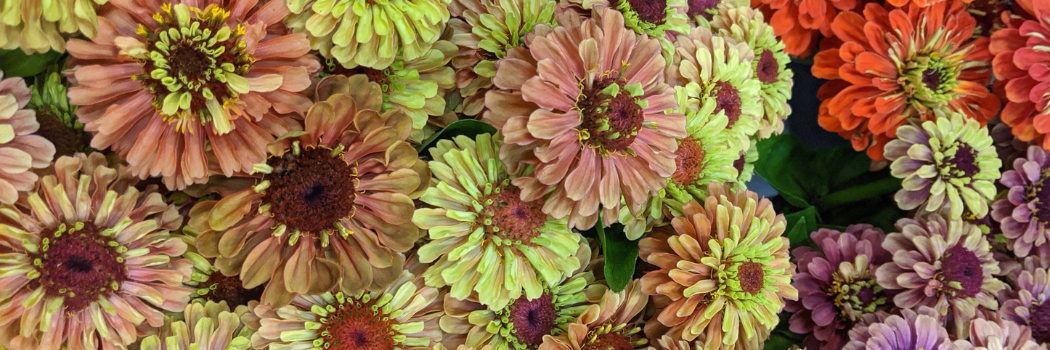
Floral Standards for Collectives and Cooperatives
By Diane Szukovathy, Seattle Wholesale Growers Market, May 2025
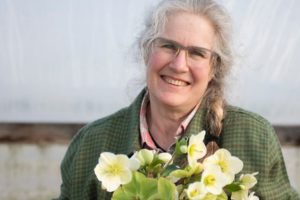
Diane Szukovathy, Seattle Wholesale Growers Market
Photo © Mary Grace Long
Diane Szukovathy is the co-founder with her husband Dennis Westphall of Jello Mold Farm in Mount Vernon, Washington. A flower farmer for nearly two decades, she previously designed and maintained Seattle area gardens through Jello Mold Landscape. Jello Mold helped establish the Seattle Wholesale Growers Market in 2011 and Diane has served on the cooperative’s board since its beginning. These days, Diane and Dennis say they are more “leaf farmers” than flower farmers, as their 5-acre farm has matured to produce foliage, greenery, and woody flowering branches that complement botanicals from other farms. Diane is a frequent presenter for flower farming and gardening audiences. Most recently, she worked with growers and staff to coordinate the SWGM Floral Standards book, a tool which is intended to help flower farmers work together to build a lasting industry based on quality and shared knowledge.
On This Page
Grow Sales Successfully with Best Practices
For any flower farmer, regardless of farm size and marketing channels, the ability to deliver quality and consistency greatly enhances the potential for thriving in business. In this specialized industry, appearance and reliability matter above almost everything. Consider sweet peas. When properly harvested and well handled, a local bunch will bring a fleeting bit of heaven to the customer, nostalgia perhaps fed by knowing that the best local ones last just five days. If not well handled, the customer will remember their disappointment in wilting and shedding flowers, a worthless purchase.
The Importance of Crop-Specific Best Practices
As with vegetable farming, each floral crop has different requirements for stage of harvest and handling. Many flower farmers grow as many as 50 or 100 distinctly different crops. Without knowing and following the specifics of each, a farmer plays roulette. A weekly bouquet which contains sunflowers harvested at the correct stage so that they last 10 days will make an impression, as will one which shatters in a few days because the flowers were harvested when fully open. Interesting to note that these two examples may have been grown with the same quality and care in the field, but have very different results in the customer’s hands, depending on the farmer’s harvest and post-harvest handling knowledge.
These factors become even more important when selling to professional florists and other wholesale customers, whose buying power is many times that of an individual farmers’ market or farmstand customer—and whose branding and reputation are at stake in the products they purchase. Quality becomes essential to building and maintaining customer relationships. The farther floral products travel and the greater bulk in which they are sold, the more important the farmer’s product handling knowledge becomes.
Developing the Floral Standards Reference Book
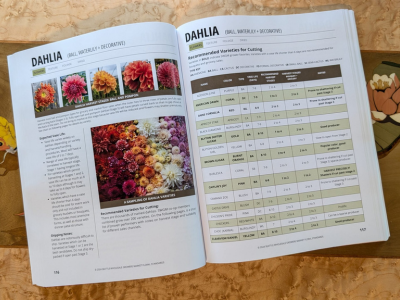
Floral Standards: A Practical Guide for Harvesting and Delivering Professional Quality Products
Formatted like a cookbook, this practical guide is overflowing with expert knowledge to help growers produce professional quality florals from start to finish. It covers 230 cut floral crops and has 425+ full color photos throughout.
Photo © Seattle Wholesale Growers Market Cooperative.
Selling collectively—through cooperatives and other similar business models—adds yet another dimension, because it isn’t just a single farm’s reputation that is at stake. And yet, selling collectively brings many advantages, mainly in sharing resources and expanded offerings to customers. This is a truth which I have lived on my own five-acre farm, which relies almost exclusively on selling through a farmer-owned cooperative, the Seattle Wholesale Growers Market.
Founded in 2011, our co-op has worked hard to cultivate a reputation for supplying a diverse selection of high-quality, seasonal botanicals. Today, our member-owners include 19 Washington and Oregon flower farms, and we distribute the products of numerous additional west coast growers, year round.
Our collective structure offers many benefits, including a wide selection of products and an extended availability of many floral categories, due to our growers’ various microclimates between the Canadian border to the north and Oregon’s lower Willamette Valley to the south. The combined talents of our farms located up and down this nearly 400-mile Pacific Northwest range means we can deliver Seattle area florists and designers far more quality and quantity during a longer stretch of time than a single flower farm can provide. Additionally, while many customers regularly shop the market floor in person, our online sales and regional deliveries are steadily on the rise.
Last fall, we published Floral Standards, a comprehensive, 333-page reference book to guide our growers who bring their products to our wholesale market. Based on our internal specification sheets and established standards, the book represents years of practical, farm-based research and the accumulated know-how of our experienced growers. In this book, we have compiled the essential data for 230 top floral crops.
Given the explosion of new wholesale flower hubs across North America and beyond, we recognize that regardless of their legal structure (for-profit operations, marketing collectives, and legal cooperatives among them), entities that sell local flowers on behalf of numerous farms face some of the same challenges we encountered in our early years. Building a shared brand of quality takes intentionality and open communication between growers, as well as good grower-staff communication. Having a tool which helps us define quality collectively has been essential to creating and upholding an excellent business reputation and providing exceptional floral experiences for our valued customers.
Quality Begins in the Field

Members of the Seattle Wholesale Growers Market Cooperative, March 2025.
Photo © Seattle Wholesale Growers Market Cooperative.
Labor Considerations
As specialty cut flower growers, we plant crops that will thrive in available soil and microclimate conditions. We site them well and attend to their needs, with the goal of producing high quality crops with strong, healthy stems. As the harvest stage approaches, the farmer’s attention switches from cultivating to harvesting. And this is where Floral Standards provides essential guidance. The book addresses post-harvest care practices by crop and includes definitions of hydration solutions; low-sugar holding solutions; floral preservatives; and crop-specific holding solutions. Also covered are best practices for storage and transport, including cooler hygiene, floral cooler temperatures, conditioning, long-term storage, packing materials, packing for transport, and cold chain consideration.
Harvesting Benchmarks
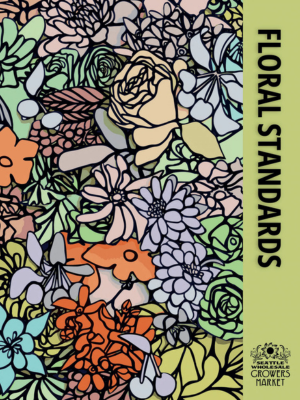
Floral Standards was written by flower farmers for flower farmers, growers, and gardeners.
Photo © Seattle Wholesale Growers Market Cooperative.
Here are some of the harvesting benchmarks in Floral Standards. These practices are applicable for farms that specialize in wholesale (to the trade) or retail (direct-to-consumer) sales:
- Monitor crops regularly for pests and diseases: Sell only good-quality, undamaged stems.
- Hydrate crops before harvesting: Irrigate the evening or day before harvest to allow time for plants to uptake water. This is especially important for woody, delicate, or short-lived crops.
- Clean tools and buckets: Keep a “food-grade clean” standard, washing buckets regularly (inside and out) to prevent bacteria and ensure clean product display.
- Know the correct harvest stage: This varies by crop and is critical for quality and vase life.
- Know time of day to harvest: Some crops perform better when harvested in cooler parts of the day; others benefit from afternoon harvest.
- Heft and stem counts: Maintain uniformity in bunches. Based on the individual spec sheets in Floral Standards, always include at least the number recommended. If stems are thin, have few or no laterals, or if the flower heads are smaller than typical, include more stems. Exercise judgement about bunch heft so that customers receive fair and comparable value from bunch to bunch and farm to farm.
- Growers bunches: Every crop is different. Some, such as strawflowers and asters, grow a strong central leader with thinner side branches. When this is the case, we recommend a range of stems. We recommend including both types of stems in a bunch to provide value.
- Good bunch grooming: For neat and tidy bunches, cut stems to correct height and specifications; strip leaves below the water line; trim stems even; use rubber bands at the bottom of each bunch; apply twist ties, hang tags, and sleeves with care.
- Cut stems directly into water or post-harvest solution rather than making piles to process later. If bunches sit out of water for any length of time, recut them before placing back in bunches.
- Promptly remove field heat: Keep freshly harvested bunches in the shade while working and transport as soon as possible to the cooler. This is especially important for short-lived crops such as lilacs and sweet peas, and for crops that need to stay at a certain harvest stage, such as peonies and tulips. Hot weather increases the importance of paying attention to this step for nearly all crops.
Floral Standards gives our growers a common language across many unique crops. Throughout the year, we produce hundreds of different annuals, perennials, bulbs, foliages, woody ornamental crops, and more. Even though we have obvious experts and experienced growers in our cooperative, none of us can remember all of the specs for every crop from season to season. When trying out new crops, I can refer to Floral Standards and feel confident about its specific stage of harvest, as well as the best varieties that other farms have found successful. Our farmers have vetted these entries, by genus, cultivars and hybrid varieties, calling out best-selling and top producing candidates. A flower can look enticing on a Pinterest board or in an online catalog, but our farmers answer the question: can you make money growing that specific cultivar or named variety?
Harvest & Post-Harvest Floral Standards for 7 Top Crops
To give you a sneak peek into the pages of Floral Standards, here are harvest and post-harvest excerpts on seven top floral crops:
Celosia (Celosia cristata; C. argentia; C. spicata)
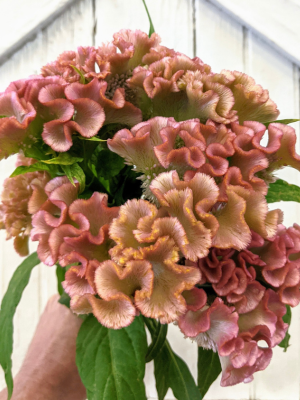
Harvest cockscomb celosia when flower heads have reached desired size.
Photo © Seattle Wholesale Growers Market Cooperative.
- Harvest Stage:
- Cockscomb Types (C. cristata): when flower heads have reached desired size. Avoid harvesting blooms too late in order to prevent browning on lower parts of flowers and messy seed drop. Blooms harvested too late will develop unsightly browning on lower parts of flowers and may start to drop seeds.
- Plume and Wheat Types (C. argentia, and C. spicata): when ½ of flowers on a stem are open. If harvested too early, immature stems tend to wilt. Blooms harvested too late will develop unsightly browning on lower parts of flowers and may start to drop seeds.
- Post-Harvest Care: Harvest and hold in plain water. Store at 45°F (7°C). Storage at temperatures below 41°F (5°C) for even a few days can cause black spotting on flowers and death of cell tissue.
- Stems per bunch:
- Cockscomb Types (C. cristata): 5–7 stems depending on flower size and stem girth.
- Plume and Wheat Types (C. argentia, and C. spicata): 8–10 stems.
- Standard Height: 16–20 inches.
- Expected vase life: 10–14 days.
- Shipping Notes: Ships well dry-packed.
Lisianthus (Eustoma grandiflorum)
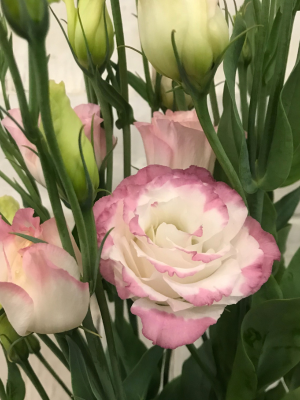
For market floor sales, harvest lisianthus when up to three flowers on a stem are open.
Photo © Seattle Wholesale Growers Market Cooperative.
- Harvest Stage: For market floor sales, harvest when up to three flowers on a stem are open. Remove first bloom if it is starting to look old or damaged, so that overall look of bunches is fresh and high quality. Buds showing color will continue to open after harvest. For grocery and shipping, harvest when one flower per stem is open and secondary buds are showing color. For best vase life, harvest in the afternoon when plants have captured carbohydrates from the sun.
- Post-harvest care: Harvest and hold in low-sugar holding solution (Chrysal #2 T-bag or similar). Can store up to 2 weeks at 35–41°F (2–5°C). Slow-release chlorine tablets recommended for long-term storage. Stems are geotropic. Store and pack upright to maintain straight stems.
- Stems per bunch: 5–14 stems. Note: First-harvest central stems are beefy and can be packed with 5 to 8 stems; mid-stage bunches generally take 10 stems and the last bunches harvested from a crop will be side branches with up to 14 stems.
- Standard Height: 16–20 inches.
- Expected vase life: 7–10 days.
- Shipping Notes: Can ship dry-packed for short periods of time when harvested at tighter stage.
Ranunculus (Common/Romance™ Types)
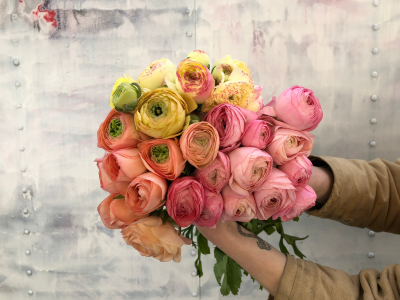
Ranunculus flowers open in the day and close at night. For best quality local sales, allow blooms to open and close once or twice before harvesting.
Photo © Seattle Wholesale Growers Market Cooperative.
- Harvest Stage: Ranunculus flowers open in the day and close at night. For best quality local sales, allow blooms to open and close once or twice before harvesting. Size of blooms can vary considerably depending on variety type, cultural care and stage of harvest. If harvested in bud stage before they have opened, flowers will be smaller although quality and vase life will be good. If harvested after buds have opened a number of times, they will no longer close and vase life will be diminished.
- Post-harvest care: Harvest into low-sugar holding solution (Chrysal Bulb Bag, #2 T-bag or similar). Stems are fragile and snap easily. Handle and transport with care. Sleeving or adding a rubber band or tie below flower heads helps protect stems from tangling in buckets.
- Stems per bunch: 10 stems (standard); 15 stems (mini-buds ½-inch or smaller).
- Standard height: 14–16 inches.
- Expected vase life: 10–14 days.
- Shipping Notes: Ranunculus flowers ship well dry-packed if harvested at tighter stage.
Snapdragon (Antirrhinum majus)
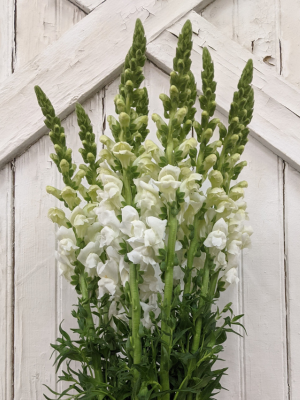
Harvest snapdragons when 3–5 flowers are open on a stem.
Photo © Seattle Wholesale Growers Market Cooperative.
- Harvest Stage: Cut when 3–5 flowers are open on a stem. Strip leaves above the water line. Stems are fragile and snap easily. Strip, handle and transport with care.
- Post-harvest care: Harvest and hold in low-sugar holding solution (Chrysal #2 T-bag or similar). Can be stored up to 6 days at 32–35°F (0–2°C). Snapdragons are geotropic. Store upright and pack full buckets to maintain straight stems during storage and transport. Some varieties are ethylene sensitive. Keep cold and in an ethylene-free environment.
- Stems per bunch: 10–15 (laterals and thinner cuts require more).
- Standard Height: 18–24 inches.
- Expected vase life: 8–14 days. Use of floral preservative is recommended.
- Shipping Notes: Snapdragons can be packed flat and dry shipped for air freight if harvested and conditioned as specified. Wrap bunches in paper or perforated plastic to protect stems from breaking in transit.
Sunflower (Helianthus annuus)
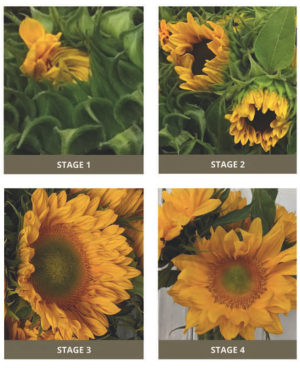
Sunflower harvest stages.
Photo © Seattle Wholesale Growers Market Cooperative.
- Harvest Stage: Sunflowers have a narrow harvest window. Blooms develop rapidly, especially on warm days. It may be necessary to harvest 2-3 times per day, especially during warm weather, to catch flowers at correct stage. Move harvested stems rapidly from field to cooler to prevent further opening after harvest.
- Stage 1: Petal is unfurling from tight bud. This stage is recommended for longer term shipping.
- Stage 2: Center is visible, petals are colored up, but still held tightly forward. Tiny florets in center disc should not yet be opening. This is optimal harvest stage for all sales channels, including grocery and shipping.
- Stage 3: Petals are more developed, but still pointing straight forward; appropriate harvest stage for market floor sales only.
- Stage 4: Petals are open and a double ring of florets is fully open in center. Cutting at this stage significantly reduces vase life. Flowers harvested at this stage should not be brought to market.
- Post-harvest care: Harvest and hold in low-sugar holding solution (Chrysal #2 T-bag or similar). Additional use of slow-release chlorine tablets may be beneficial, especially during warm weather. Can be stored at 36-41°F (2-5°C). for up to 1 week. Flowers travel better when harvested at tighter stages. Take care to preserve the cold chain during handling and transport as flowers open quickly when warm.
- Stems per bunch: 5 stems (Standard); 10 stems (Novelty/Mini).
- Height: 28–30 inches (Standard); 20 inches (Novelty-Mini).
- Expected Vase Life: 6–10 days depending on variety.
- Shipping Notes: Can ship dry-packed. Harvest at Stages 1 or 2 to prevent petal damage in transit.
Tulip (double, parrot, and single hybrid)
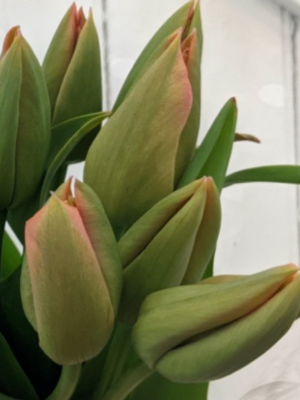
For optimal quality, harvest tulips when buds show color, but are not yet opening.
Photo © Seattle Wholesale Growers Market Cooperative.
- Harvest Stage: For optimal quality, harvest when buds show color, but are not yet opening. Flowers will open reliably from this stage and are suitable for all sales channels. Tulips must be harvested several times per day, especially during warm weather. If harvested too early, buds will open, but flowers will remain small. Tulips harvested when fully colored and beginning to open are suitable for market floor sales only, not for long-term storage, grocery sales or shipping. Vase life will be diminished if harvested later.
- Post-harvest care: For short-period storage, harvest by cutting stems at base of bulbs and store up to 1 week in low-sugar bulb holding solution (Chrysal Bulb T-bag or similar). Tulips are phototropic. Store upright and keep stems straight in buckets. Stems will continue to stretch after cutting. Handle carefully during transport because flower heads snap off easily. Sleeving may be helpful in preventing damage.
- Stems per bunch: 5 (double and parrot); 10 stems (single hybrid).
- Standard Height: 12–16 inches.
- Expected Vase Life: 7–10 days.
- Shipping Notes: Ships well dry-packed if harvested at tighter stage.
Zinnia (Zinnia elegans; Z. haageana)
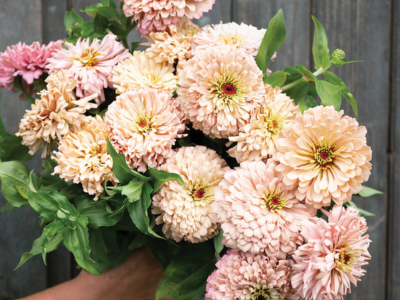
Zinnias are a crop that needs to get to market—and into the hands of customers—as soon as possible after harvest.
Above: 'Ballerina' Zinnia.
- Harvest Stage: Monitor zinnias every few days in order to catch them at optimal harvest stage. Stems on immature flowers are rubbery. Harvest as soon as possible after stems have firmed up. The inner ring of yellow pollen petals may be showing at this stage. Centers will still look tight and fresh. If harvested too early, stems will bend in transport. Varieties which have been bred to be double, such as Benary’s Giant and the Queeny Series, will shoot some single and semi-double “sports.” Avoid including single flowers in standard bunches. To achieve longest vase life, harvest in the afternoon when plants have captured carbohydrates from the sun.
- Post-harvest care: Because zinnias are susceptible to bacterial stem rot, it is extra important to use clean harvesting tools and buckets. Handle bunches with care and do not overpack. Hollow stems bend and break easily. Stems are hairy, so they collect extra pollutants which can foul the water. Transfer bunches into clean water after harvesting. Use of low-release chlorine tablets is recommended. Avoid using holding solutions and floral preservatives because the sugar they contain can cause browning of petals—especially in white, cream and green varieties. Zinnias are a crop that needs to get to market—and into the hands of customers—as soon as possible after harvest. Do not store for longer than 3 days before delivering. Recommended storage temperature is 40–45°F (4–7°C).
- Stems per bunch: 5 (Benary’s Giant, Uproar Rose, Queeny Series); 10 (smaller-blooming varieties).
- Standard Height: 14–16 inches.
- Shipping Notes: Dry-pack shipping not recommended for periods longer than a few hours.
Stage of Harvest Considerations for Shipping
With just these seven examples, it’s easy to see how much variability for correct harvest and handling exists from crop to crop. Knowledge helps farmers to make informed decisions when selling through different channels. For example, allowing ranunculus blooms to open once or twice before harvesting will guarantee best show and quality for local sales, but harvesting tighter buds will ensure reliable quality for shipping to more distant markets. Same flower, but harvested at different stages, depending on which channel it is intended for.
Snapdragons are another example where harvest stage matters and a grower might harvest when flowers are more open for farmers’ market sales and tighter for dry-pack shipping. Zinnias can be tricky to ship longer distances because they do not do well packed out of water and also have a naturally short-ish vase life. This presents an excellent opportunity for a quality-minded local grower who will always have the best ones in town if following quality standards.
It has been our experience in the Seattle Wholesale Growers Market that the saying “knowledge is power” definitely holds true for harvest and post-harvest care. It is our hope that the information in Floral Standards will be equally useful to growers in other areas—whether selling together or independently.
Learn More
- Collective Selling Models for Flower Farmers: Flower Hubs That Work • Article
- Producer Cooperatives for Small-Scale Farmers • Webinar
- 5 Factors That Determine Vase Life of Cut Flowers • Article
- Cut-Flower Harvesting & Post-Harvest Care• Article
- Building a Better Market Bouquet: Tips & Techniques for Flower Farmers • Article

